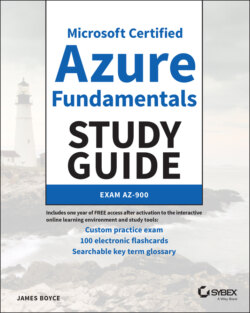Читать книгу Microsoft Certified Azure Fundamentals Study Guide - James Boyce - Страница 21
What's Included in the Book?
ОглавлениеThis book consists of seven chapters plus supplementary information: a glossary, this introduction, flashcards, and the assessment test after the introduction. The chapters are organized as follows:
Chapter 1, “Cloud Concepts,” explores the basic concepts of cloud computing to lay the foundation for the rest of the book. Chapter 1 covers categories of cloud computing, the financial benefits of cloud computing, and the various cloud models available with Microsoft Azure.
Chapter 2, “Azure Core Services,” explores the core services available with Azure, including key concepts such as subscriptions and billing, tenants, resources, and resource management. The chapter begins the exploration of key Azure services, including virtual machines, storage, and data services.
Chapter 3, “Azure Core Networking Services,” begins with an explanation of basic networking concepts to create a framework for the discussion of Azure‐specific networking services. The chapter explores virtual networks, load balancers, VPN gateways, and content delivery networks.
Chapter 4, “Security, Compliance, Privacy, and Trust,” covers concepts, services, and solutions in Azure related to security,, compliance, privacy, and trust. Topics covered include Azure network security resources, authentication and authorization, and key Azure security services such as Security Center, Key Vault, and others. The chapter also covers governance methodologies, compliance resources, monitoring and reporting, privacy and compliance topics, and government implementations of Azure for the United States and China.
Chapter 5, “Azure Solutions,” covers services in Azure for Internet of Things (IoT), big data and analytics, artificial intelligence (AI), serverless computing, and DevOps.
Chapter 6, “Azure Pricing, Service Levels, and Lifecycle,” helps you understand subscriptions, ways to purchase Azure services, and how to estimate and manage costs in Azure. Pricing tools including the TCO Calculator and Pricing Calculator are explored, as are service level agreements (SLAs), ways to improve SLAs (and the potential effect of SLAs on cost), and other ways to manage cost in Azure.
Chapter 7, “Creating and Managing Azure Resources,” begins with an exploration of the tools you can use to create and manage Azure resources, including the Azure portal, PowerShell, the Azure CLI, the Azure Cloud Shell, and the Azure Mobile App. The chapter finishes with sections that step you through the process of creating several types of Azure resources.
Each chapter begins with a list of the objectives that are covered in that chapter. The book doesn't cover the objectives in order. Thus, you shouldn't be alarmed at some of the odd ordering of the objectives within the book. At the end of each chapter, you'll find a couple of elements you can use to prepare for the exam:
Exam Essentials This section summarizes important information that was covered in the chapter. You should be able to perform each of the tasks or convey the information requested.
Review Questions Each chapter concludes with review questions. You should answer these questions and check your answers against the ones provided after the questions. If you can't answer at least 80 percent of these questions correctly, go back and review the chapter, or at least those sections that seem to be giving you difficulty.
The review questions, assessment test, and other testing elements included in this book are not derived from the exam questions, so don't memorize the answers to these questions and assume that doing so will enable you to pass the exam. You should learn the underlying topic, as described in the text of the book. This will let you answer the questions provided with this book and pass the exam. Learning the underlying topic is also the approach that will serve you best in the workplace—the ultimate goal of a certification.
To get the most out of this book, you should read each chapter from start to finish and then check your memory and understanding with the chapter‐end elements. Even if you're already familiar with a topic, you should skim the chapter; Azure is complex enough that there are often multiple ways to accomplish a task, so you may learn something even if you're already competent in an area.
